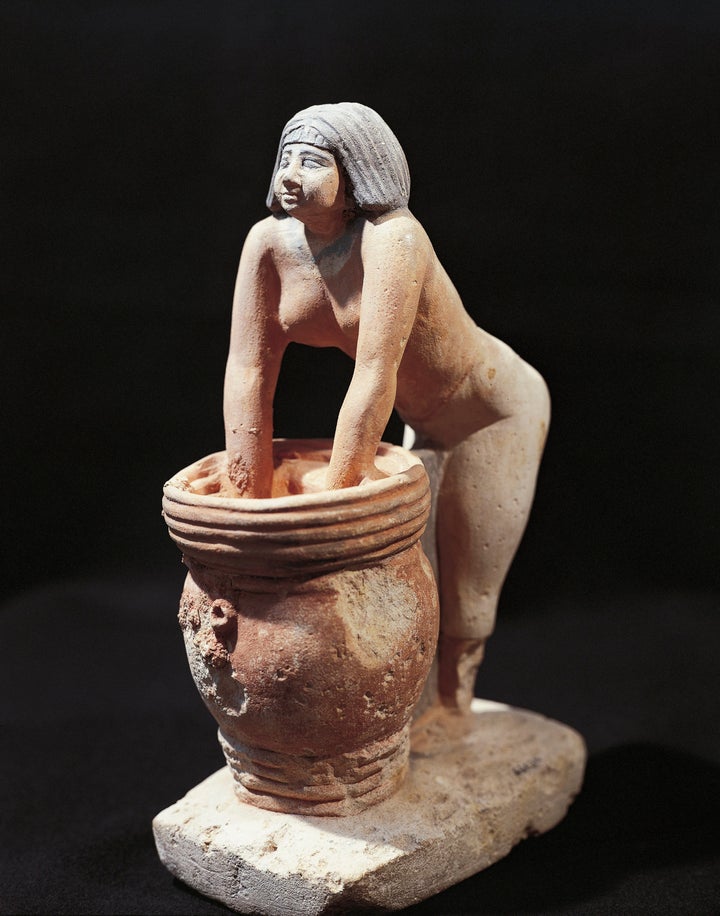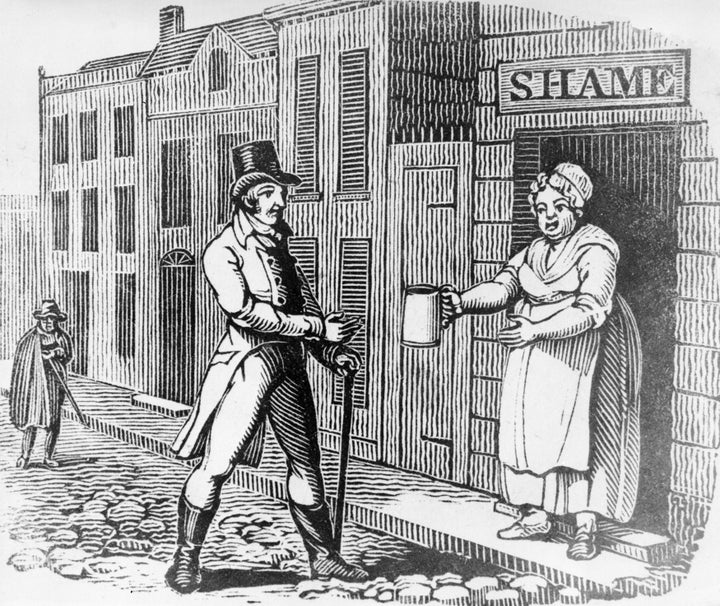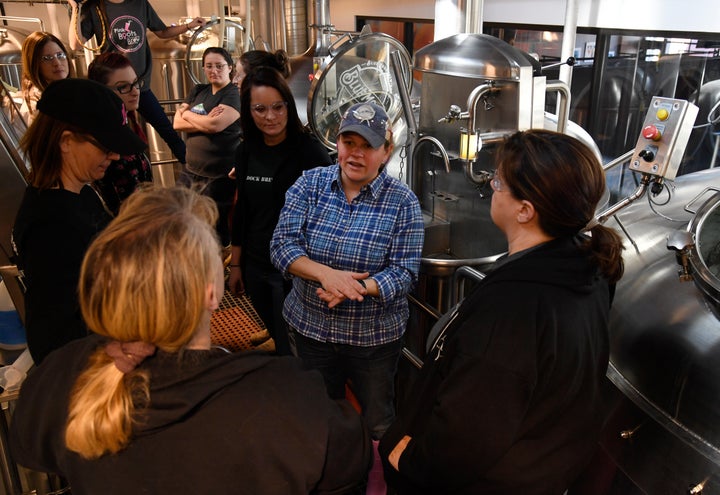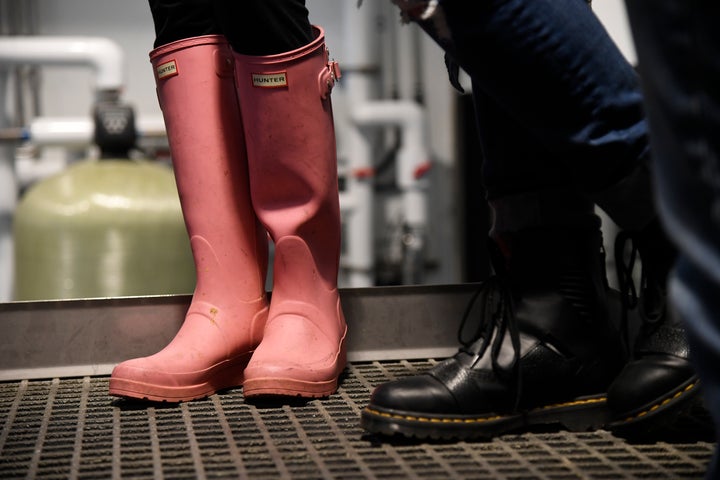
Beer has come a long way in its 5,000-year history. Today, women as brewery owners, brewers, beertenders, beer writers and beer consumers are rapidly chipping away at the perception of beer as a man’s drink. For centuries from beer’s inception, though, beer was intrinsically linked to women.
The first written beer recipe is considered to be the Hymn to Ninkasi, circa 1800 B.C. Ninkasi was the Sumerian goddess of beer, and the Sumerians were one of the first peoples who left us hard evidence of beer-drinking. Beer predates that recipe, though: Archaeologists have placed the first fermented beverage consumption at roughly 9,000 years ago and the first signs of beer, specifically, about 4,000 years later. Many believe beer propelled the shift from Paleolithic to Neolithic civilization when hunter-gatherers realized they’d have to settle in one place to reliably harvest grain.
Right from the start, brewing, a kitchen task, was women’s work. Both the Sumerians and Egyptians praised beer goddesses and associated brewing with women. In addition to Ninkasi as a woman to look up to, the Sumerians also had Kubaba. She is the only woman on the Sumerians’ list of kings, and she earned her ruling role not through birth, but through her work as a brewer. The Egyptians worshipped goddess of beer Menqet, and celebrated sun god Ra’s daughter, Sekhmet, whose bloodthirsty ways were calmed by beer.

Even as beer became a product to sell, women remained in charge. Patty Hamrick, a writer with a master’s in archaeological anthropology, teaches a class called The Archaeology of Beer at the Brooklyn Brainery. She points to the Babylonian Code of Hammurabi from Mesopotamia, one of civilization’s first set of written laws, as evidence of women’s authority in beer.
“[The Babylonian language] Akadian is a gendered language, and every time a law is listed for anything having to do with a tavern — like not overcharging for beer — every mention of a tavern owner uses ‘she,’” Hamrick said.
The concept of an alewife emerged around the fifth century A.D. Women were making large volumes of beer for their families and often had a surplus, so they’d signal that they had extra beer for sale by placing greenery over their doors, or in some cases, a broom. (Alewives sometimes also stood on corners to advertise, wearing tall hats, and had cats to chase the pests that ate their grain; it’s theorized that the alewife image gave way to the witch image.) Some alewives — or “brewsters,” a term for female brewers — even set up rough versions of bars in their homes.

Hamrick places the shift of brewing from women to men around the development of brewing guilds. The earliest guild was founded in London around 1200, and they existed more widely by the 1500s.
“This is when we begin to see people making rules for how a beer is brewed, and the use of hops is becoming prevalent, so beer would last longer and you could make larger quantities at a time and ship it to different cities and even countries,” Hamrick told HuffPost. “Beer was becoming larger-scale than before.”
While hops and their preservative powers were the beginning of the end for women’s dominance in brewing, it’s believed to be a woman who first wrote about their scientific properties, says Jeffrey Pilcher, an author and professor of food studies at the University of Toronto Scarborough. Benedictine abbess Hildegard of Bingen was a brewer and herbalist who described using hops in beer in the 12th century.
When beer grew from a cottage industry to a big business with an import/export trade, it was no longer in the household domain. In addition to guilds, government officials set rules to take advantage of beer’s selling power. In Bruges, the first association of brewery workers met in 1447 to protect themselves from “innkeeper, woman, and provost.”
The Industrial Revolution further improved the efficiency of brewing and shipping beer worldwide. By the dawn of the 20th century, beer production — and subsequently, beer consumption — was firmly in the hands of men.
“Beer became known as a man’s beverage because it was made by men,” says Teri Fahrendorf, a brewmaster for three decades and founder of the Pink Boots Society, an organization for women in the beer industry. “The teamwork that had existed earlier in beer [production] went away, and women had a new image: demure, virginal, married. Suddenly it was maybe not so ladylike to have a beer.”
When Western women began entering the workforce en masse during the 1960s and 1970s, breweries became an option for employment. It’s been a struggle to overcome consumer attitudes and tone-deaf marketing campaigns — from objectifying women to suggesting they need their own special beer — but real change is happening, especially in more recent years.
“There are many women in the beer industry today, exponentially more than when I began my career,” says Tonya Cornett, R&D brewmaster at 10 Barrel Brewing in Bend, Oregon. “Women are plugging along and making a significant impact. … Most female brewers I know want to be known for the quality of the beer they make, rather than constantly focusing on the fact that they are female.”
Statistics are hard to come by, but a study by a Stanford University research team found that 20 percent of American breweries open in 2014 had a female co-founder; only 2 percent were exclusively female-owned. Furthermore, only 4 percent of the breweries they coded had a female head brewer or brewmaster.

It’s slow but steady going, and good news isn’t difficult to find. In 2014, Belgium got its first female Trappist brewmaster. More women are opening breweries in America’s booming craft industry, and the range of jobs women are exploring in beer is expanding, from becoming Cicerones who consult on bar and restaurant beer programs to those with science backgrounds running quality control for breweries or starting yeast labs. On a consumer level, a recent Brewers Association study found 31 percent of craft beer drinkers are women, up from 29 percent in 2015, points out Grace Weitz, who has a master’s in food studies and is the marketing manager at beer magazine Hop Culture.
Women’s growth in today’s industry is evident in the ever-increasing membership of the Pink Boots Society. The organization started as a list of all the female brewers Fahrendorf met or heard about on a cross-country brewing trip in 2007. There were 60 people on her first list, and 16 brewers and six beer writers at the first PBS meeting in 2008. According to current PBS President Laura Ulrich and board member Jen Jordan, there are now 2,090 members, 72 state chapters and 13 international chapters, and they are growing at a rate of 157 new members per month.
Hop Culture celebrated the role of women in beer today with a weeklong Beer With(out) Beards festival in August. Spearheaded by Weitz, events included panels on women’s beer history and on women in beer media and a festival featuring breweries that have female owners and/or employees.
“[It] came together because of an experiment that I did,” Weitz says. “I asked people to close their eyes and think about the last beer they had ... think about the aromas, the flavors, then think about the person that made that beer. Are they short or tall, blonde or blue-eyed, are they a big, bearded man or a woman? Nine times out of 10, they pictured this stereotypical big, burly man.”
Weitz and Hop Culture sought to create spaces for conversations to take place, for both men and women to take what they learned to their own communities and keep pushing boundaries. The events made a noticeable impact, according to Ann V. Reilly, events and promotions coordinator at Five Boroughs Brewing Co.

“[The festival crowd] was hands down the most diverse group of people I’ve ever seen at a New York City beer event. Every single gender, background, race, and way people choose to identify was covered,” she says.
The well-rounded attendance of Beer With(out) Beards is a mark of the progress women are making in an industry they helped establish centuries ago as well as the progress that still needs to be made — and the motivation women have to get there.
“Minds are changing, like in any industry,” Reilly says. “We had a taproom employee who is a woman, 5 feet tall and very slight but can easily lift a bag of grain like anyone else. Beer is for everyone, it doesn’t matter your background. We need to let go of stereotypes.”
Some women in the industry think it’s less important to understand the history of women’s role in beer as long as we’re focused on evolving attitudes today, while others, like Weitz, think understanding the history will help us avoid repeating our past (of edging women out of beer). She’s hopeful that with events like Beer With(out) Beards and organizations like the Pink Boots Society spreading awareness now, gender won’t need to be a topic of discussion in the future.